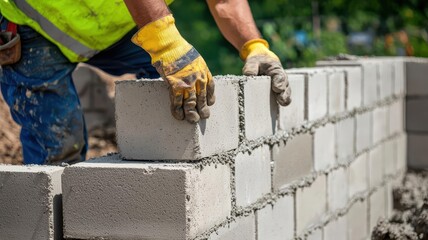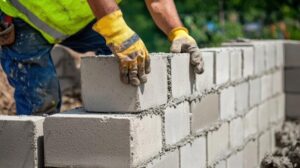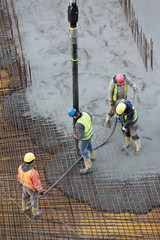Concrete Contractors Greensboro NC are specialized professionals that turn construction visions into tangible reality. They are responsible for ensuring that concrete projects are completed properly and efficiently.

Concrete is a durable material that requires special expertise to install and repair. Expert commercial concrete contractors have the knowledge and skills to handle all aspects of a concrete project, from pouring to finishing, ensuring that the finished product meets design specifications and is built to last. These professionals can also provide maintenance services, such as crack repair and resurfacing, to extend the lifespan of existing concrete structures and improve their appearance.
When selecting a contractor for your project, consider how much experience they have with the scope of work you need. Having extensive experience in the field can help them navigate challenges that may arise during construction and ensure that your project is completed on time and within budget. Asking for examples of past projects and requesting references can help you gauge a contractor’s level of experience.
In addition to experience, you should also consider the contractor’s overall level of professionalism. This includes their communication style, customer service values, and how they manage disputes and conflicts. Asking for references and access to a portfolio can help you evaluate these factors.
You should also look for a contractor with the right equipment and tools to complete the job. Depending on the type of concrete work you need, some projects may require specialized tools that are costly to rent or buy. Inquire about the types of equipment the contractor has available and whether it is properly maintained.
Finally, make sure you get detailed quotes from each contractor you are considering. Look for a breakdown of costs by item, so you can see where each dollar is going and compare prices side by side. Also, be sure to find out about any downpayment requirements and payment methods. This will help you avoid unexpected surprises and delays during the project. In addition to comparing quotes, take the time to visit potential contractors’ websites and social media pages to read public reviews. Reading through positive and negative reviews can give you a better idea of what to expect from your contractors and how they treat their customers.
Reputation
Reputation is a critical component to consider when choosing the right concrete contractor. The best contractors have a strong online presence with verified reviews and testimonials from satisfied clients. A good reputation shows that a contractor delivers high-quality results, meets deadlines, and maintains professionalism during the project.
Ask potential contractors for references and inspect completed projects to gauge their quality. Look for smooth finishes, precise edges, and uniformity in color and texture. Also, discuss the types of materials and their sourcing, as this will affect durability and lifespan. Ask contractors how they plan to manage any unexpected delays or challenges during construction, and find out their strategies for minimizing impact on timelines and costs.
A top-rated contractor will offer a comprehensive warranty on their work, including both labor and materials. This ensures your investment in a new concrete surface is protected and gives you peace of mind that the job will be done properly. Be wary of contractors who don’t provide a warranty or only offer a limited warranty, as this may be an indication that they aren’t confident in the quality of their work.
Effective communication is essential to a successful construction project, and it starts with selecting a contractor who is easy to work with. Choose a contractor who listens attentively to your needs and goals, provides transparent cost estimates, and keeps you updated on the progress of your project. Ask contractors how they prefer to communicate during the project, such as daily check-ins with email recaps or scheduled meetings.
Inquire about the contractor’s certifications, which demonstrate their knowledge of industry standards and best practices. A contractor who is actively involved in their field and committed to excellence will continually improve their skills, offering a higher level of service.
Look for contractors with licensing and insurance coverage, which are required by local authorities. This will indicate their compliance with regulations and a commitment to accountability and professionalism. Verify that they have liability and workers’ compensation insurance, as this will protect you in the event of injuries or property damage during construction.
Insurance
Concrete Contractors play a vital role in construction projects, and their work requires precision throughout every step of the process. Unfortunately, like all businesses, they can face a variety of liabilities and accidents. That’s why having the right insurance coverage is so important. In many cases, it’s even a requirement before a concrete company can begin operations.
Concrete Insurance can protect concrete contractors from the financial impact of common business claims, including property damage, bodily injury and product liability. It can also cover the costs of legal defense and settlements, such as those that result from lawsuits filed by customers over miscommunication or workmanship issues. Some insurance providers offer additional coverage options, such as professional liability, which is a type of insurance that covers damages related to errors or omissions in the work that a concrete contractor performs for a client.
Another insurance option is tools and equipment coverage, which safeguards the valuable assets of a concrete contractor against typical hazards such as theft and vandalism. This type of coverage is often offered as an add-on to general liability policies. In addition, concrete contractors should consider securing pollution liability coverage. This is a separate policy that can provide reimbursement for clean-up costs and legal fees associated with environmental incidents.
It’s also a good idea to confirm that the concrete contractor you plan to hire has the state-required licenses and is properly bonded. This shows that the contractor is serious about their work and will adhere to all regulations. Lastly, you should also find out whether the contractor has workers’ compensation insurance in case an employee is injured while working on your project.
Aside from providing the necessary protections for concrete contractors, having the right insurance can help them attract more customers. This is because showing proof of adequate insurance can give them a competitive edge in the market, and it may also be a requirement for certain projects. In addition, commercial landlords typically require concrete contractors to have proof of insurance before signing a lease agreement. So securing the right insurance is a must-do for concrete contractors to grow their business and stay competitive in the industry.
Portfolio
Concrete Contractors have an eye for detail and work well with architects, engineers, and other construction professionals. They have a passion for their craft and find satisfaction in building structures that last a lifetime. They work with a wide variety of materials and follow strict safety and building codes to ensure their concrete work is safe and structurally sound. They also use decorative elements to enhance the appearance of concrete projects. They pay close attention to how the concrete is poured, smoothed, and finished, as this can make a significant difference in the final product. They use different techniques to achieve the desired texture and finish.



